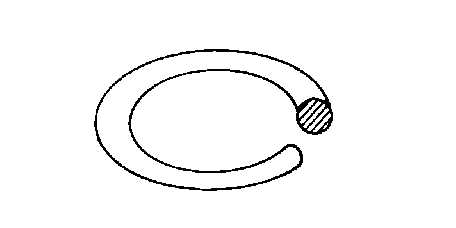TM 1-1500-204-23-2
NOTE
·
The fitting nipple should be restrained while applying torque to the nut at the fitting to prevent galling
of the sealing surfaces. All adapters to hose fitting threads and contact surfaces shall be lubricated
prior to application of torque.
·
To find the dash size of a given fitting look on the fitting itself at the part number which is stamped on
it. The last number of the part number following the dash is the fitting size, in sixteenths of an inch.
·
If the part number is not stamped on the fitting, measure the outside diameter of the tubing or the
inside diameter of the hose to which the fitting is attached.
4-7.
Hydraulic Packings and O-Rings. Hydraulic seals are used throughout aircraft hydraulic systems to prevent
internal and external leakage of hydraulic fluid, thereby preventing loss of system pressure. Seals used between non-
moving components are called gaskets, which are generally referred to as O-rings. Seals inside a sliding or moving part
are called packings.
a.
O-Rings. O-rings used as gaskets are used in the sealing of boss fittings, end caps of actuators, piston
accumulators, and other installations where moving parts do not come in contact with the seal. Some O-rings are used
as packings where relative motion is encountered Figure 4-58 shows a typical O-ring cross section.
(1)
Identification. O-rings are manufactured according to military specifications. They are identified from
the technical information printed on the O-ring package (see fig. 4-59). Because the size of O-rings cannot be positively
identified by visual examination without the use of special equipment, O-rings are packaged in Individual sealed
envelopes labeled with all the necessary data. Colored dots, dashes, and stripes or combinations of dots and dashes on
the surface of the O-ring are no longer used to identify O-rings.
(2)
Storage Proper storage practices must be observed to protect O-rings. Most synthetic rubbers are
not damaged by several years of storage under ideal conditions. Their enemies are heat, light, oil, grease, fuels,
solvents, thinners, moisture, strong drafts, or ozone (form of oxygen formed from an electrical charge). Damage by
exposure is magnified when rubber is under tension, compression, or stress. Conditions to be avoided include the
following:
·
Defects in shape resulting from improper stacking of parts and from storage In improper containers.
·
Creasing caused by force applied to corners and edges any by squeezing rings between boxes and
storages containers.
·
Compression and flattening as a result of storage under heavy parts.
·
Punctures caused by staples used in attaching identification.
·
Hanging O-rings from nails or pegs where they are apt to become dirty and to develop defective
shapes (O-rings should be kept in their original envelopes).
·
Allowing rings to become oily or dirty by fluids leaking from parts stored above and adjacent to O-ring
surfaces.
·
Applying adhesive tape directly to O-ring surfaces (a torn O-ring package should be secured with a
pressure-sensitive, moisture proof tape, but the tape must not contact the O-ring surface.
·
Keeping over-age parts as a result of improper storage arrangements or unreadable identification O-
rings should be arranged so that older seals are used first.
Figure 4-58. O-Ring
4-79

